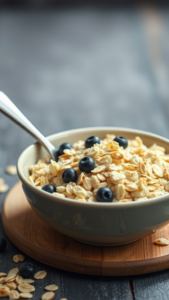Can You Have Oatmeal on a Keto Diet? Exploring the Carb Content
When it comes to the keto diet, the focus is primarily on keeping your carbohydrate intake low while increasing your fat and protein consumption. With this strict carb limit, many wonder if they can still enjoy a bowl of warm oatmeal. Understanding the basics of oatmeal’s nutritional content can help you make informed choices while following this low-carb lifestyle.
Oatmeal is a beloved breakfast food for many due to its wholesome texture and rich fiber content. But on a keto diet, where staying within a strict carb limit is crucial, knowing if oatmeal fits into your meal plan is key.
Carbohydrate Content of Oatmeal
The first step in examining whether oatmeal can work in a keto diet is to look at its carbohydrate content. Oats, in general, are relatively high in carbohydrates. Here’s a breakdown of the carbohydrate content in various types of oatmeal:
| Type of Oatmeal | Serving Size | Total Carbohydrates (g) | Net Carbs (g) |
|---|---|---|---|
| Instant Oats | 1 packet (28 g) | 27 g | 25 g |
| Rolled Oats | 1/2 cup (40 g) | 27 g | 25 g |
| Steel-Cut Oats | 1/4 cup (40 g) | 30 g | 27 g |
As you can see from the table, even a small serving of oatmeal can significantly impact your daily carb intake. The net carbohydrates, which are calculated by subtracting fiber from total carbs, remain high enough to potentially exceed your limit.
Oatmeal Alternatives on Keto
Given that oatmeal is not typically keto-friendly, you may wonder what alternatives you can include in your breakfast or meal plans. Here are a few popular choices that mimic the texture of oatmeal but are lower in carbs:
- Chia Seed Pudding: Chia seeds are high in fiber and healthy fats, making them a perfect low-carb option.
- Flaxseed Meal: This can be mixed with water to create a thick porridge-like consistency.
- Coconut Flour Porridge: Use coconut flour to create a filling breakfast with a delightful taste.
- Almond Meal or Almond Flour Porridge: Both options provide healthy fats and are low in carbohydrates.
Proper Portion Control
If you’re truly craving oatmeal, monitoring your portion size is essential. A very small amount might fit into your daily carb allowance, but this often involves sacrifices elsewhere in your diet. If you still want to include oatmeal occasionally, you could try:
- Limiting the serving size to no more than 1-2 tablespoons.
- Adding low-carb toppings, such as nuts or seeds, to increase healthy fats.
- Balancing the rest of your meals to stay under your daily net carb limit.
Consider Your Individual Goals
When contemplating the inclusion of oatmeal in your diet, think about your specific goals. Some individuals may be able to incorporate tiny portions of oatmeal while maintaining ketosis, especially if they’re more active. However, others who are stricter with their diets may need to avoid it entirely.
Ultimately, understanding your body’s response and how closely you want to stick to the keto diet will influence whether you choose to have oatmeal. Experimenting to find what works for you—with oatmeal or its alternatives—can create a satisfying breakfast routine without compromising your keto journey.
To sum up, while traditional oatmeal is generally not suitable for a keto diet due to its high carbohydrate content, mindful alternatives and portion control can offer satisfying options. Always keep track of your daily carb intake to stay on track successfully with your keto goals.
Alternative Low-Carb Breakfast Options for Keto Followers
Embracing a keto diet often means cutting down on carbohydrates significantly. While oatmeal is a popular breakfast choice for many due to its nutritional benefits, it doesn’t fit well into the low-carb guidelines of this diet. Fortunately, there are plenty of alternative breakfast options for those following a ketogenic lifestyle. These options not only keep your carb count low but also provide vital nutrients and great flavors.
Egg-Based Dishes
Eggs are a staple for anyone on a keto diet. They’re low in carbs, high in protein, and incredibly versatile. Here are some delightful egg-based breakfast ideas:
- Scrambled Eggs: Simple yet satisfying, scrambled eggs can be customized with cheese, spinach, or avocado.
- Omelets: Fill your omelet with mushrooms, bell peppers, and cheese for extra flavor and nutrients.
- Egg Muffins: Whisk eggs with veggies and bake them in a muffin tin for on-the-go breakfast options.
Dairy and Non-Dairy Alternatives
Dairy into your breakfast can make it more filling while keeping carbs low. Here’s how:
- Greek Yogurt: Opt for full-fat, unsweetened Greek yogurt. Top it with berries or nuts for added texture without too many carbs.
- Cottage Cheese: High in protein and low in carbs, cottage cheese can be enjoyed with a sprinkle of cinnamon or some chopped almonds.
- Nut Milk: Almond, coconut, or cashew milk can be used to create smoothies or can serve as a dairy alternative in recipes.
Vegetable-Based Breakfasts
Vegetables not only provide essential nutrients but also add bulk to your breakfast without the carbs. Consider these options:
- Cauliflower Rice: Sauté cauliflower rice and mix with eggs or use it as a base for a breakfast bowl.
- Avocado Toast (Keto Version): Use carb-free bread alternatives and top them with smashed avocado and eggs for a filling meal.
- Spinach and Feta Pie: Made with almond flour or coconut flour crust, this pie can be rich in flavor and nutrients.
Meat and Fish Choices
Adding meat or fish to your breakfast can not only enhance flavor but also boost your protein intake:
- Breakfast Sausages: Homemade sausage patties are easy to prepare and can be flavored with your choice of spices.
- Bacon: This classic breakfast item is low in carbs and can be paired perfectly with eggs or avocado.
- Smoked Salmon: A luxurious option, smoked salmon can be served with cream cheese on low-carb bread or with cucumber slices.
Low-Carb Smoothies
Smoothies can be a perfect way to kick-start your day. By focusing on low-carb ingredients, you can create delicious options:
- Spinach Smoothie: Blend spinach with almond milk, a few berries, and some nut butter for a nutrient-packed drink.
- Coconut Smoothie: Use coconut milk along with avocados and your favorite low-carb sweeteners for a creamy, indulgent option.
Keto-Friendly Cereal Alternatives
If you miss the crunch of cereal, try these alternatives:
- Nuts and Seeds: A mix of nuts like almonds, walnuts, and seeds such as chia or flax provide a great base for a breakfast bowl.
- Homemade Keto Granola: Use unsweetened coconut flakes, nuts, and a low-carb sweetener to create your granola.
Sample Low-Carb Breakfast Options
| Breakfast Option | Net Carbs (per serving) | Calories (per serving) |
|---|---|---|
| Scrambled Eggs with Spinach | 2g | 220 |
| Avocado and Bacon on Low-Carb Toast | 3g | 350 |
| Cottage Cheese with Berries | 5g | 180 |
| Greek Yogurt with Nuts | 7g | 300 |
Finding meals that satisfy your cravings while staying true to your keto diet can be an exciting adventure. With a wealth of delicious options available, you can enjoy a hearty breakfast that aligns perfectly with your nutritional goals. Remember to experiment with flavors and textures to find what works best for you! Each of these alternatives ensures that you are nourishing your body while keeping those carbs in check.
The Role of Fiber in a Keto Diet and How Oatmeal Fits In
When you’re on a keto diet, understanding the role of fiber is crucial. Fiber is an important part of any healthy diet, and it plays a key role in digestive health, weight management, and overall wellness. The keto diet, known for its low-carb and high-fat approach, raises questions about whether traditional high-fiber foods, like oatmeal, can fit in this dietary framework.
Fiber can be classified into two types: soluble and insoluble. Soluble fiber dissolves in water, forming a gel-like substance that can help lower blood cholesterol and glucose levels. Insoluble fiber does not dissolve in water and helps add bulk to stool, which aids in digestion. Both types are essential, but they come from different sources.
Here’s how fiber aids your body and why it’s especially relevant for those following a keto diet:
- Supports Digestive Health: Fiber helps to promote healthy bowel movements and prevents constipation, which can be a concern on a low-carb diet.
- Helps Regulate Blood Sugar: Soluble fiber can slow glucose absorption, which is beneficial for maintaining steady energy levels without spikes.
- Promotes Satiety: High-fiber foods can keep you feeling full longer, which is beneficial for weight loss or maintenance.
- Helps Control Cravings: When you consume fiber-rich foods, they can satisfy your hunger while providing fewer calories.
Now, the question arises: can you have oatmeal on a keto diet? Traditional oatmeal is often viewed as off-limits in a strict keto regimen due to its higher carbohydrate content. A typical serving of rolled oats contains approximately 27 grams of carbs, which can quickly exceed your daily carb limit if you’re aiming for 20-50 grams. So, in its conventional form, oatmeal doesn’t quite fit into the keto framework.
However, there are alternatives that provide the benefits of fiber without derailing your keto goals:
| Oatmeal Alternative | Carbs (per serving) | Fiber (per serving) |
|---|---|---|
| Chia Seeds | 1 gram | 10 grams |
| Flaxseed Meal | 1 gram | 3 grams |
| Hemp Seeds | 1 gram | 1 gram |
| Ground Psyllium Husk | 0 grams | 7 grams |
| Nut-Based Porridge (e.g., almond meal) | 5 grams | 3 grams |
These alternatives are excellent sources of fiber and fit seamlessly into a keto lifestyle. them into your meals allows you to reap the health benefits associated with fiber while adhering to your dietary restrictions.
Many people might miss the comforting texture and taste of traditional oatmeal, but there are plenty of keto-friendly recipes that capture that essence. For example, a chia seed pudding can mimic the appeal of oatmeal. Here’s a simple recipe:
Keto Chia Seed Pudding Recipe:
- Mix 1 cup of unsweetened almond milk with 2 tablespoons of chia seeds.
- Add a sweetener of your choice, such as erythritol or stevia.
- Let it sit overnight in the fridge to thicken.
- In the morning, top with nuts or low-carb berries.
This dish allows you to get a great dose of fiber while keeping your carb intake low, keeping your body in ketosis.
It’s clear that while traditional oatmeal isn’t ideal for a keto diet because of its carb content, you can still enjoy a varied diet rich in fiber by choosing alternative sources. By being mindful of your food choices, you can maintain overall health, while still enjoying your keto journey.
Remember to experiment with different fiber sources to find what you enjoy most, and be sure to listen to your body’s needs. Your digestive health—and your keto success—depends on it!
Tips for Enjoying Oatmeal While Staying in Ketosis
Eating oatmeal might seem off-limits while following a keto diet, but there are ways to enjoy it without kicking yourself out of ketosis. Let’s explore some tips on how to savor oatmeal while maintaining your low-carb lifestyle.
Understand Oatmeal Carbohydrates
First, it’s crucial to know that traditional oatmeal is high in carbohydrates. For those on a keto diet, which typically restricts daily carbohydrate intake to around 20-50 grams, oatmeal can quickly take up that allowance. A standard serving of rolled oats contains about 27 grams of carbs. However, by choosing lower-carb alternatives and adjusting portion sizes, you can still enjoy the experience of oatmeal.
Opt for Low-Carb Oatmeal Alternatives
Many low-carb options can mimic the texture and taste of oatmeal. Here are a few replacements to consider:
- Flaxseed Meal: High in fiber and low in carbs, flaxseed meal can be cooked with water or unsweetened almond milk to create a warm, porridge-like dish.
- Chia Seeds: Chia seeds are not only low in carbs but also packed with omega-3 fatty acids. Mix them with almond milk and let them thicken overnight for a creamy treat.
- Psyllium Husk: This fiber-packed option can be used to create a thick oatmeal-like consistency. Just add water and simmer for a few minutes.
- Golden Flaxseed or Coconut Flour: Both are excellent, low-carb choices that can be mixed with eggs and water to form a pancake-style breakfast.
Watch Your Portions
If you decide to include traditional oatmeal as an occasional treat, keep your portions small. A medical professional or a dietitian can help you determine the right amount based on your dietary goals. Consider limiting yourself to just a few tablespoons of oats and keeping track of your overall carb intake for the day.
Add Healthy Fats
Enhancing your oatmeal with healthy fats can make it more satisfying and effective for a keto diet. Some great options include:
- Butter: A classic addition that adds flavor and fat.
- Coconut Oil: Provides a tropical taste and is great for boosting ketone production.
- Nuts and Nut Butters: Almonds, walnuts, or a spoonful of peanut butter can enhance the flavor while keeping carbs low.
- Heavy Cream: Swirl in some heavy cream for a rich, creamy base.
Incorporate Low-Carb Toppings
When topping your oatmeal-like dish, choose low-carb options to keep it keto-friendly. Here are some delicious suggestions:
- Berries: Raspberries, strawberries, and blackberries are lower in sugar and can add a refreshing touch.
- Unsweetened Cocoa Powder: For a chocolatey flavor without the carbs.
- Seeds: Pumpkin seeds or sunflower seeds can add a satisfying crunch.
- Cinnamon and Vanilla Extract: Both spices can enhance sweetness without added sugar.
Experiment with Recipes
Finding the right recipe can elevate your low-carb oatmeal experience. Try different combinations until you find your favorite. Don’t be afraid to mix flavors, or even add a scoop of protein powder to make your meal more filling. Here’s a simple low-carb oatmeal recipe to get you started:
| Ingredient | Quantity |
|---|---|
| Ground Flaxseed | 1/4 cup |
| Almond Milk | 1 cup |
| Chia Seeds | 1 tbsp |
| Cinnamon | 1 tsp |
| Butter or Coconut Oil | 1 tbsp |
Instructions: Combine all ingredients in a saucepan, heat over medium heat, and stir until thickened. Top with your favorite low-carb toppings!
By understanding the carb content, choosing the right ingredients, and experimenting with recipes, you can enjoy oatmeal while adhering to a keto diet. With these tips, you can satisfy your cravings while staying on track with your dietary goals.
Nutritional Comparisons: Oatmeal vs. Keto-Friendly Grains
When you embark on a keto diet, you might wonder how foods like oatmeal stack up against other low-carb grains. Oatmeal is often celebrated for its health benefits, but does it fit into a ketogenic lifestyle? Understanding the nutritional comparisons will help you make informed choices.
Nutritional Breakdown
Oatmeal is a popular breakfast choice due to its fiber content and energy-boosting properties. However, it is essential to look closely at its nutritional values compared to keto-friendly grains, which typically include options like chia seeds, flaxseeds, and almond flour.
| Grain Type | Calories (per 100g) | Carbohydrates (g) | Fiber (g) | Net Carbs (g) | Protein (g) | Fat (g) |
|---|---|---|---|---|---|---|
| Oatmeal | 389 | 66 | 10 | 56 | 17 | 7 |
| Chia Seeds | 486 | 42 | 34 | 8 | 17 | 31 |
| Flaxseeds | 534 | 29 | 27 | 2 | 18 | 42 |
| Almond Flour | 575 | 20 | 10 | 10 | 21 | 51 |
From the table above, you can easily see how oatmeal compares nutritionally to some keto-friendly options:
- High Carbohydrate Content: Oatmeal has a high carbohydrate count at 66g per 100g, making it less suited for keto, where daily carb intake is limited to around 20-50g.
- Fiber Benefits: While oatmeal offers fiber, the net carb count remains significantly higher than keto grains, meaning it would disrupt ketosis.
- Protein Content: Oats present a decent amount of protein, but there are better options like flaxseeds that provide higher protein with a lower carbohydrate profile.
- Fat Levels: Unlike keto-friendly grains, oatmeal lacks healthy fats, which are crucial for remaining in ketosis.
Health Benefits of Ketogenic Grains
Keto-friendly grains provide more than just low-carb benefits; they can enhance your health in various ways:
- Heart Health: The high levels of Omega-3 fatty acids in chia and flaxseeds promote cardiovascular health.
- Weight Management: Low-carb keto-friendly grains tend to keep you full longer, assisting with weight loss and management.
- Blood Sugar Control: These alternatives can stabilize blood sugar levels due to their lower glycemic index.
On the other hand, oatmeal may offer advantages like:
- Rich in Antioxidants: Oatmeal contains antioxidants that can help reduce inflammation and improve heart health.
- Versatile Uses: Oats can be used in a variety of recipes, which might appeal to those looking for diversity in their meals.
So, Can You Have Oatmeal on a Keto Diet?
The answer is generally no if you aim to maintain strict ketosis. The high carbohydrate content in oatmeal can hinder your progress. However, if you are in a more moderate phase of your diet, a small portion might be acceptable, but be careful to balance it with other low-carb options throughout the day. Always track your macro intake to ensure you stay within your desired carb limits.
While oatmeal has its nutritional benefits, it is not compatible with a traditional keto diet due to its high carbohydrate content. Keto-friendly grains, on the other hand, provide lower carbs, more healthy fats, and higher protein options that support a ketogenic lifestyle. By choosing wisely, you can maintain your dietary goals while still enjoying delicious and nutritious foods.
Conclusion
When considering whether you can have oatmeal on a keto diet, it’s essential to weigh the carb content against your personal dietary goals. Traditional oatmeal is relatively high in carbohydrates, making it a less-than-ideal choice for those strictly adhering to keto principles. However, there are low-carb alternative options available that can still offer that comforting breakfast experience without kicking you out of ketosis.
Fiber plays a crucial role in any diet, including keto, as it aids digestion and can help maintain satiety. While oatmeal does provide fiber, the types of low-carb grains and seeds, like chia seeds or flaxseeds, offer similar benefits with fewer carbs.
If you crave oatmeal but are worried about staying in ketosis, there are creative ways to enjoy a keto-friendly version. You can try using low-carb oatmeal substitutes or incorporate fats like nut butters and coconut milk to tweak the taste while keeping the carb count low.
Ultimately, it’s about understanding your body and how different foods affect your state of ketosis. Always consider your cravings and nutritional needs, and opt for alternatives that align with your lifestyle. By making informed choices, you can enjoy the breakfast you love without compromising your keto journey. Embrace the flexibility of the keto diet, explore delicious and nutritious options, and keep the focus on feeling good while meeting your dietary goals.




